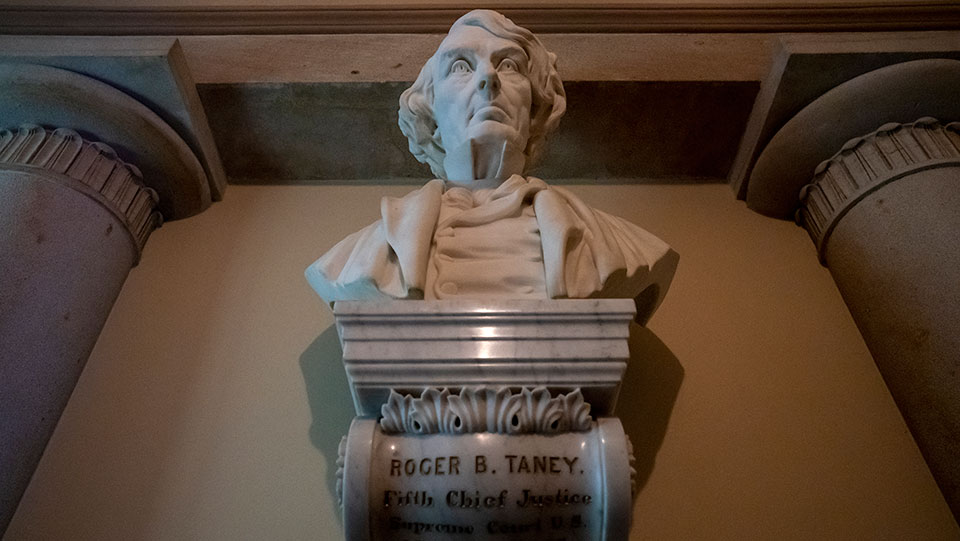
WASHINGTON—By a 305-113 vote, the Democratic-run U.S. House voted to eject statues of Confederate leaders, plus racist U.S. Supreme Court Chief Justice Roger Taney, from the U.S. Capitol, especially Statuary Hall. Republicans cast all 113 “no” votes, while 72 GOPers joined all 232 voting Democrats and the lone Independent in deciding to toss out the rebels.
Led by Congressional Black Caucus members, Speaker Nancy Pelosi, D-Calif., and Majority Leader Steny Hoyer, D-Md., lawmakers from both parties paraded to the podium to laud the removal of statues of 12 Confederates, three leaders of the slave South prior to and during the Civil War and Taney, author of the infamous 1857 Dred Scott decision saying Blacks were not citizens and had no rights.
The others to be tossed include two of the South’s most-notorious “fire eaters,” South Carolina Sen. John C. Calhoun, who also served briefly as U.S. vice president, and the Confederates’ top two officials: Jeff Davis of Mississippi and Alexander Stephens of Georgia. Both were senators.
Each state gets to send two statues to Statuary Hall. There are a total of 102 “Hall” statues: 100 from states, abolitionist and Black leader Frederick Douglass from D.C., and, by special legislation, Rosa Parks. A bust of Dr. Martin Luther King is in the Capitol rotunda and Sojourner Truth, the Underground Railroad leader, is in the new Capitol visitor center.
All the dumped statues would be shipped to the Smithsonian Institution for storage or back to the states that donated them. None would be destroyed. The legislation, HR7573, also bars states from replacing the removed statues with those of other rebels.
“All of these statues were donated many decades after the Civil War,” said Rep. C.K. Butterfield, D-N.C., a former Black Caucus chair whose subcommittee handled the bill. “Like many other statues around the country honoring members of the CSA, and particularly those erected in the South, these statues were not donated and installed in the Capitol until the 1900s, during the height of Jim Crow.”
“Many Americans see these statues and the timing of their placement as a means to intimidate African Americans and to perpetuate the notion of white supremacy. We must not continue to honor these combatants by allowing their images to be on display in the Capitol.”
Pelosi previously ordered the removal of four paintings of ex-Speakers who became rebels. They were taken off Capitol walls on Juneteenth, June 19, considered the real Black emancipation day, as June 19, 1865, is when the last slaves in Texas learned about the Emancipation Proclamation.
The 16 statues to be removed “similarly exemplify bigotry and hate,” Pelosi said. She called them “monuments to men who advocated barbarism and racism” and “a grotesque affront” to U.S. ideals.
In Dred Scott, Taney ruled Blacks were not U.S. citizens and “have no rights a white man has to respect.” It’s been called the worst Supreme Court ruling ever, and one direct cause of the Civil War.
Taney’s bust is at the entrance to the old U.S. Supreme Court chamber in the Capitol basement. Taney, a Marylander, would be replaced by another bust, that of fellow Marylander Thurgood Marshall, the first Black justice on the court and the NAACP’s lead attorney in convincing the court in 1954 to unanimously outlaw segregation in the famous Brown vs Board of Education case.
Taney’s removal prompted a GOP foe of yanking the statues to speak up, Rep. Tom McClintock, R-Calif., and even he blasted the Dred Scott ruling.
“But if we remove memorials to every person in this building who ever made a bad decision—and his was the worst—well, this will be a very barren place, indeed. It is only by the bad things in our history that we can truly measure all of the good things in our history,” McClintock protested. He pleaded for leaving the decision to the states. “If we are going to start down that road” of removing such depictions, “we are going to be swapping out statues like trading cards.”










